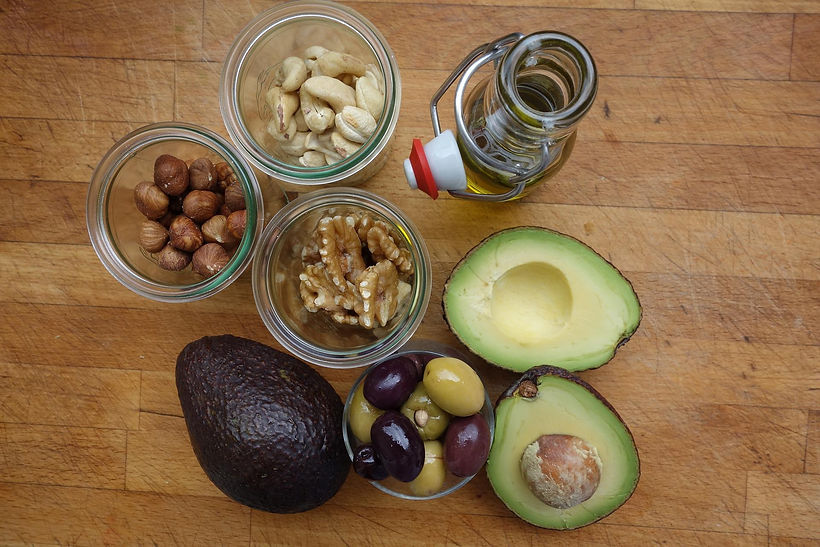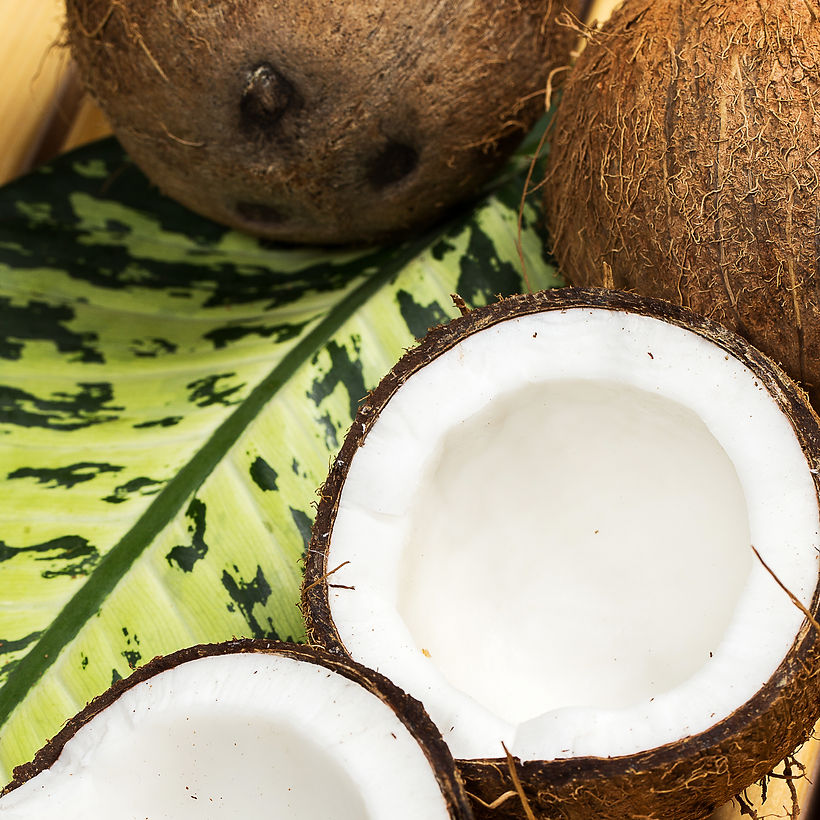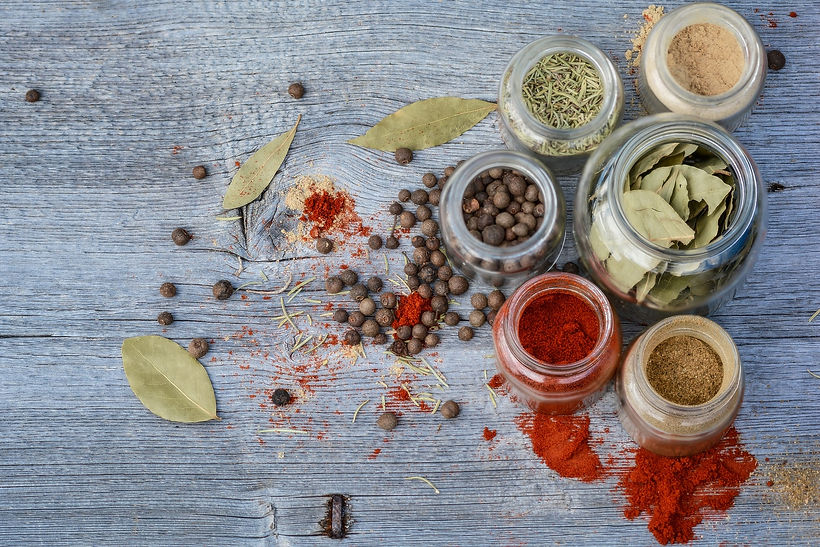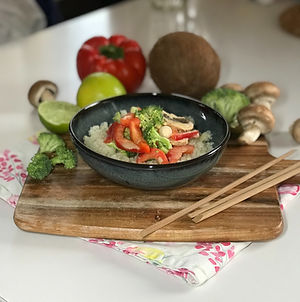Diet Concern Values
Since we are a vegan blog, the following information refers to plant-based sources of nutrients. We would also like to show you that with a conscious vegan diet you are very well supplied with everything your body needs for its work and well-being.
After reading this page we will have learned what are the diet concern values and when are they considered a concern for our lifestyle. In the last section of this page we will show you our Bell Pepper System which can be found in each recipe page of our blog. It helps you to adopt a more conscious and balanced diet by keeping the diet concern values under control.
Total fats
In addition to carbohydrates and proteins, fats are the third macronutrient in our diet. Just like carbohydrates, fats can be converted into energy by the body. Our body continuously burns fat in order to carry out the required physical activities, such as speaking, breathing, moving, etc. One gram of fat provides twice as much energy as one gram of carbohydrates.
They also have the ability to bring fat-soluble vitamins into the body. They also serve as the building blocks of cells and muscle tissue. Excess fat is stored in the body in the form of fat cells. Here it serves us as a long-term energy reserve or as protection against the cold. This means that fats also have their place in a healthy diet. The DGE (German Society for Nutrition)¹ and the WHO (World Health Organization)² agree that a value below 30% of the daily energy intake is optimal.
But there are big differences between the individual fatty acids within the group of fats. A distinction is made between saturated and unsaturated fatty acids and trans fats. Saturated fatty acids can be recognized by the fact that they are solid at room temperature. An example that illustrates this is cheese. Saturated fats are usually easy for the body to process and quickly go into energy metabolism. They are converted into energy by the body very quickly. They are mostly found in animal foods, but there are also some plant foods that are high in saturated fat. These are coconut oil, coconut milk and avocados. However, according to the current state of scientific research, the amount of saturated fatty acids should be kept small. Because they can increase our cholesterol levels and thus the risk of cardiovascular diseases and diabetes³. The DGE (German Society for Nutrition)⁴ recommends that saturated fatty acids contribute to maximum 7% to 10% of the total energy intake and the WHO (World Health Organization)⁵ recommends not to exceed 10% in relation to the total amount of calories. Since a plant-based diet excludes a large proportion of saturated fatty acids, namely those found in animal products, there is no reason in our opinion to ban the plant-based representatives mentioned: Coconut oil is only very rarely used in Clean & Yummy recipes. It also has advantages such as high heatability compared to other oils. Likewise, a moderate use of coconut milk in a vegan diet will not have any negative consequences. It is also important to look at food in its entirety, so avocados have around 12g of fat (of which around 3g are saturated fatty acids, but mostly "healthy" fatty acids), as well as 4g of fiber and numerous vitamins and trace elements. So the conclusion that avocados are not healthy is completely absurd.

Free Stock photos by Vecteezy
Unsaturated fatty acids, on the other hand, remain liquid at room temperature. They have many positive properties for our health⁶: The unsaturated fatty acids have a positive influence on our cholesterol level, they can bring it back into balance or even lower the overall level. They are also important for vitamin absorption and have an antioxidant effect, so they protect our cells from dangerous free radicals. The unsaturated fatty acids are essential, which means we cannot produce them ourselves, we can only get them from food. They are found in fish but also in nuts, seeds and vegetable oils. With Clean & Yummy recipes, you can easily reach a healthy level of unsaturated fatty acids, as we often use nuts and seeds as healthy fat carriers. The ratio of omega 3 and omega 6 fatty acids is also important when it comes to unsaturated fatty acids. If you want to find out more about this, read more here.
Trans fats are fats that are usually chemically solidified. This means they are no longer as oily in consistency and also preserve for a long time, which was and is still very useful for the food industry. Fried foods, instant sauces and baked goods in particular often contain trans fats. In some countries like the USA, Canada and Denmark trans fats are banned, but not in the EU. Not a single health-benefit effect of trans fats is known⁷. However, they are associated with some health risks and diseases. For example, they increase "bad" LDL cholesterol and decrease "good" HDL cholesterol, and such a shift in ratios is positively correlated with various cardiovascular diseases. Therefore, trans fats should be avoided at all costs. Clean & Yummy's recipes and recommended products are always free of trans fats.
Saturated Fatty Acids
There are different types of fat. While some are considered extremely healthy, nutritional science recommends limiting the amount of saturated fat. Therefore, they must always be shown separately in the nutritional values in food packaging. Clean & Yummy follows these regulations and always states the proportion. Since saturated fat is almost exclusively found in animal foods, with a few exceptions such as coconut milk, coconut oil and avocados, you will rarely exceed the limits in this regard with the recipes from our vegan blog. However, if a little more coconut milk is used in a recipe, that is not a problem. Because it is more about evaluating your diet as a whole and not so much about demonizing or praising individual dishes.

Free Stock photos by Vecteezy
Salt
Our body cells need salt for various vital processes. It is found in trace amounts in various foods and is also used isolated worldwide as table salt for seasoning. According to the DGE (German Society for Nutrition)⁸, 6g of salt a day is advisable, which corresponds to about one teaspoon. According to the WHO (World Health Organization)⁹ it should only be 5g a day. However, most people consume more and this makes too much salt throughout the day. This is because, on the one hand, we season too much with salt and, secondly, there is a relatively large amount of salt in the vast majority of processed foods, which you do not necessarily always detect, but which is included in the daily value. Too much salt dehydrates our body, which is why we react with thirst. The healthy intestinal bacteria also decrease with increased salt consumption. In addition, excessive salt consumption has a negative effect on blood pressure and the cardiovascular system.
The recipes from Clean & Yummy always try to use the salt in a finely nuanced way and to set new accents with interesting flavor and spice combinations that do not need salt as a flavor carrier. The salt values given include both the added table salt, the salt content of finished products and the micro doses found in fruit and vegetables.

Free Stock photos by Vecteezy
Sugar
Sugars are a nutritional subgroup of carbohydrates. Unlike salt, our body does not need to consume sugar¹⁰. As part of the carbohydrates, the ingested sugar molecules are either immediately released as energy or stored in the form of fat cells. The remaining carbohydrates, such as cereals, legumes and starchy vegetables, as well as healthy fats, are also available to us as sources of energy. So that means you can live without added sugar from a nutritional point of view. But it's not that simple, because sugar is also found in its natural form in many types of fruit and vegetables, albeit in very small doses. Due to their high nutrient density, fruit and vegetables are of course a basic component of a healthy diet and therefore also the basis of the Clean & Yummy recipes. We also wisely use natural sweeteners such as maple syrup and coconut sugar to create healthier desserts, for example. Compared to traditional recipes, you will notice that our cakes and desserts are less sweet because we believe that the use of sugar is often exaggerated. Whenever possible, we also use the natural fruit sweetness of dates and ripe bananas, thereby completely avoiding the addition of sugar. What we basically never use is refined industrial sugar, also known as table sugar. Since it goes through numerous chemical processes until it is in white powder form, it is no longer a natural food for us and it has been proven that it no longer contains any minerals or vitamins, compared to maple syrup and coconut sugar. Table sugar also has a higher glycemic index, i.e. the factor that indicates how quickly a food causes our blood sugar level to rise¹¹.

Free Stock photos by Vecteezy
What actually happens when we regularly consume too much sugar in our diet? First of all, our body becomes exhausted due to excessive sugar intake, the blood sugar level rises sharply, whereupon the body reacts with a strong release of insulin to lower the level. Due to the rapid drop, we can again react with a feeling of hunger and this rapid succession of ups and downs makes us sluggish and tired. Also, high amounts of sugar reduce the absorption of certain minerals and vitamins. So this is extremely counterproductive. Long-term excessive sugar consumption is also associated with the clinical pictures of caries, diabetes and cardiovascular diseases¹².
But as we said, the mission of Clean & Yummy is to develop recipes of all kinds - sweet and salty - in a tasty and healthy way. Meaning that with our blog you do not need to worry, you will be always well supplied and on the healthy side!
Our Bell Pepper System Explained
We want to offer an intuitive and scientifically proven way to show how healthy a recipe is, in particular how a recipe performs in terms of nutritional elements that according to science and nutrition experts should be limited in our diets in order to keep us healthy.
After an extensive investigation about this topic we got convinced that a good option is to use a "traffic light" colors convention to classify the amount of nutritional element contained in a recipe according to the recommended healthy limits. The daily limit values we used as thresholds for each color interval for fats, saturated fats, added sugar and salt, were taken from an official government guidance document from the Department of Health and Food Standards Agency from UK¹³. In this document the amount of fat, saturated fat, salt and sugar per 100g of food is classified in three regions identified by a color.
In all or our recipe pages we use three types of bell peppers - green, yellow and red peppers - to classify the content of fats, saturated fats, salt and total sugar contained in 100 g from the recipe, in such a way that you can have feedback about how this recipe could contribute to your health according to experts. A bell pepper color is assigned for fat, saturated fat, salt and total sugar separately in the following way:

This happy green bell pepper indicates that the recipe contains a low level of a nutritional element recommended to limit, meaning fats, saturated fats, salt or total sugar. A low level of a diet concern element is the healthiest choice we can make and we should try to favor this kind of recipes as often as possible.


Whenever a recipe contains medium levels of a nutritional element that is recommended to limit, we assign a yellow bell pepper. Medium levels are still fine but we should try to limit recipes with this kind of levels and try to choose often recipes with green bell peppers.
We love for sure yellow bell peppers, as they are full of nutrients and flavor, but in this case we used them in a didactic way of identifying a nutritional recommendation.

We use a sad red bell pepper for those diet concern values that are present in high quantities in a recipe. According to nutrition experts, it is fine to eat this kind of recipes occasionally, but we need to limit them and control how often and how much of it do we eat in order to maintain a healthy diet. And again, please do not stop eating the real red bell peppers: your body and palate need them!
Now we know what each bell pepper means and how they should be used to make healthy choices. But what are the amounts of these nutritional elements that are used to define the intervals in this classification? Below we show you how much fats, saturated fats, salt and total sugar per 100g is needed to classify this elements as low, medium or high content:
Low
Medium
High



Total Fat
up to 3g
more than 3g and less than 17.5g
more than 17.5g
Saturated Fat
up to 1.5g
more than 1.5g and less than 5g
more than 5g
Salt
up to 0.3g
more than 0.3g and less than 1.5g
more than 1.5g
Total Sugar
up to 5g
more than 5g and less than 22.5g
more than 22.5g
In each recipe page, the three regions defined by the green, yellow and red bell peppers are also illustrated in a color bar as shown below. For every nutritional element, a color bar is provided, where a white indicator shows where the amount of this element is located among the different regions. With this color bar you can see with more details how low, medium or high the content of a nutritional element is.

References:
-
Deutsche Gesellschaft für Ernährung/German Society for Nutrition (2011), Richtwerte für die Energiezufuhr aus Kohlenhydraten und Fett, accessed 23 june 2022, <https://www.dge.de/fileadmin/Bilder/wissenschaft/referenzwerte/energie/DGE-Positionspapier-Richtwerte-Energiezufuhr-KH-und-Fett.pdf>
-
World Health Organization (2020), Healthy diet, accessed 23 june 2022, <https://www.who.int/news-room/fact-sheets/detail/healthy-diet>.
-
Micha, R. and Mozaffarian, D. (2010), Saturated fat and cardiometabolic risk factors, coronary heart disease, stroke, and diabetes: a fresh look at the evidence, in: Lipids, 45(10): p. 893-905.
-
Deutsche Gesellschaft für Ernährung/German Society for Nutrition (2015), Ausgewählte Fragen und Antworten zur 2. Version der DGE-Leitlinie "Fettzufuhr und Prävention ausgewählter ernährungsmitbedingter Krankheiten", accessed 23 june 2022, <https://www.dge.de/fileadmin/dok/presse/meldungen/2011-2018/FAQ-Fett-LL-2v.pdf>.
-
World Health Organization (2020), Healthy diet, accessed 23 june 2022, <https://www.who.int/news-room/fact-sheets/detail/healthy-diet>.
-
Mozaffarian, D., Micha, R. and Wallace, S. (2010), Effects on Coronary Heart Disease of Increasing Polyunsaturated Fat in Place of Saturated Fat: A Systematic Review and Meta-Analysis of Randomized Controlled Trials, in: PLOS Medicine 7 (March 2010): 1–10. DOI:10.1371/journal.pmed.1000252.
-
World Health Organization (2018), Questions and Answers, Nutrition, Trans Fat, accessed 23 june 2022, <https://www.who.int/news-room/questions-and-answers/item/nutrition-trans-fat>.
-
Deutsche Gesellschaft für Ernährung/German Society for Nutrition (2020), Ausgewählte Fragen und Antworten zu Speisesalz, accessed 23 june 2022, <https://www.dge.de/wissenschaft/faqs/salz/#c2591>.
-
World Health Organization (2020), Salt reduction, accessed 23 june 2023, <https://www.who.int/news-room/fact-sheets/detail/salt-reduction>.
-
American Heart Association (2021), Sugar 101, accessed 23 june 2022, <https://www.heart.org/en/healthy-living/healthy-eating/eat-smart/sugar/sugar-101#.WsuvJCOZM6U>.
-
Asghar, M. T. et al. (2019), Coconut (Cocos nucifera L.) sap as a potential source of sugar: Antioxidant and nutritional properties, in: Food science & nutrition vol. 8,4, p. 1777-1787, doi:10.1002/fsn3.1191.
-
World Health Organization (2015), Guideline: sugars intake for adults and children, accessed 23 june 2022, <https://www.who.int/publications/i/item/9789241549028>.
-
Department of Health (2016), Guide to creating a front pack (FoP) nutrition label for pre-packet products sold through retail outlets accessed 23 june 2022, <https://www.food.gov.uk/sites/default/files/media/document/fop-guidance_0.pdf>.